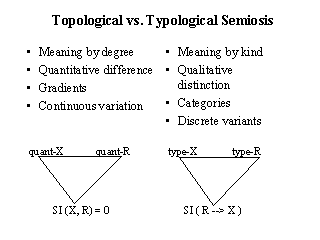
|
|
| Previous slide | Next slide | Back to first slide |
Topological semiotics represents meaning by degree rather than by categorial contrast of types. As in drawing and painting (e.g. matters of shape, texture, intensity of color); and as in quantitative representation in mathematics.
In Peircean terms, the relation of representamina to objects is that of one continuously varying material parameter to another, rather than, as in language or conventional signs, of one discrete type or category in contrast with another
There is no continuum of meaningful signs between GOOD and GOAD, variable X vs. variable Y, atomic species Carbon and atomic species Nitrogen, but there is such a continuum of possibilities in the acoustical spectrum of sounds, or between any two real numbers, or in the molar concentrations of reactants in the law of mass action in chemistry.
Note that I follow here my own reading of the C.S. Peirce's model of the semiotic sign, in which some material signifier (the representamen, R) represents or stands for some "object" (entity, process, sign, etc.=X) as interpreted by some system of interpretance (SI), which includes the entire system in and by which the interpretation of R as X is accomplished (so, for example, not just a meaning-making organism, but also the contexts and tools -- such as situations, languages, computers -- involved). Peirce uses the term 'interpretant' sometimes to mean the human interpreter of a sign, and sometimes to mean the act of interpreting or its results. In a complex systems perspective, I believe it is reasonable to generalize this to a 'system of interpretance' (SI), the ensemble or network of interdependent elements by and through which a connection between R and X is made in some particular fashion. For a different SI, the same R may represent a different X.